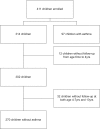Airway obstruction and bronchial reactivity from age 1 month until 13 years in children with asthma: A prospective birth cohort study
- PMID: 30620743
- PMCID: PMC6324782
- DOI: 10.1371/journal.pmed.1002722
Airway obstruction and bronchial reactivity from age 1 month until 13 years in children with asthma: A prospective birth cohort study
Abstract
Background: Studies have shown that airway obstruction and increased bronchial reactivity are present in early life in children developing asthma, which challenges the dogma that airway inflammation leads to low lung function. Further studies are needed to explore whether low lung function and bronchial hyperreactivity are inherent traits increasing the risk of developing airway inflammation and asthmatic symptoms in order to establish timely primary preventive initiatives.
Methods and findings: We investigated 367 (89%) of the 411 children from the at-risk Copenhagen Prospective Studies on Asthma in Childhood 2000 (COPSAC2000) birth cohort born to mothers with asthma, who were assessed by spirometry and bronchial reactivity to methacholine from age 1 month, plethysmography and bronchial reversibility from age 3 years, cold dry air hyperventilation from age 4 years, and exercise challenge at age 7 years. The COPSAC pediatricians diagnosed and treated asthma based on symptom load, response to inhaled corticosteroid, and relapse after treatment withdrawal according to a standardized algorithm. Repeated measures mixed models were applied to analyze lung function trajectories in children with asthma ever or never at age 1 month to 13 years. The number of children ever versus never developing asthma in their first 13 years of life was 97 (27%) versus 270 (73%), respectively. Median age at diagnosis was 2.0 years (IQR 1.2-5.7), and median remission age was 6.2 years (IQR 4.2-7.8). Children with versus without asthma had reduced lung function (z-score difference, forced expiratory volume, -0.31 [95% CI -0.47; -0.15], p < 0.001), increased airway resistance (z-score difference, specific airway resistance, +0.40 [95% CI +0.24; +0.56], p < 0.001), increased bronchial reversibility (difference in change in forced expiratory volume in the first second [ΔFEV1], +3% [95% CI +2%; +4%], p < 0.001), increased reactivity to methacholine (z-score difference for provocative dose, -0.40 [95% CI -0.58; -0.22], p < 0.001), decreased forced expiratory volume at cold dry air challenge (ΔFEV1, -4% [95% CI -7%; -1%], p < 0.01), and decreased forced expiratory volume after exercise (ΔFEV1, -4% [95% CI -7%; -1%], p = 0.02). Both airway obstruction and bronchial hyperreactivity were present before symptom debut, independent of disease duration, and did not improve with symptom remission. The generalizability of these findings may be limited by the high-risk nature of the cohort (all mothers had a diagnosis of asthma), the modest study size, and limited ethnic variation.
Conclusions: Children with asthma at some point at age 1 month to 13 years had airway obstruction and bronchial hyperreactivity before symptom debut, which did not worsen with increased asthma symptom duration or attenuate with remission. This suggests that airway obstruction and bronchial hyperreactivity are stable traits of childhood asthma since neonatal life, implying that symptomatic disease may in part be a consequence of these traits but not their cause.
Conflict of interest statement
The authors have declared that no competing interests exists.
Figures



References
-
- Busse WW, Pedersen S, Pauwels RA, Tan WC, Chen Y-Z, Lamm CJ, et al. The Inhaled Steroid Treatment As Regular Therapy in Early Asthma (START) study 5-year follow-up: Effectiveness of early intervention with budesonide in mild persistent asthma. J Allergy Clin Immunol. 2008;121(5):1167–74. 10.1016/j.jaci.2008.02.029 - DOI - PubMed

